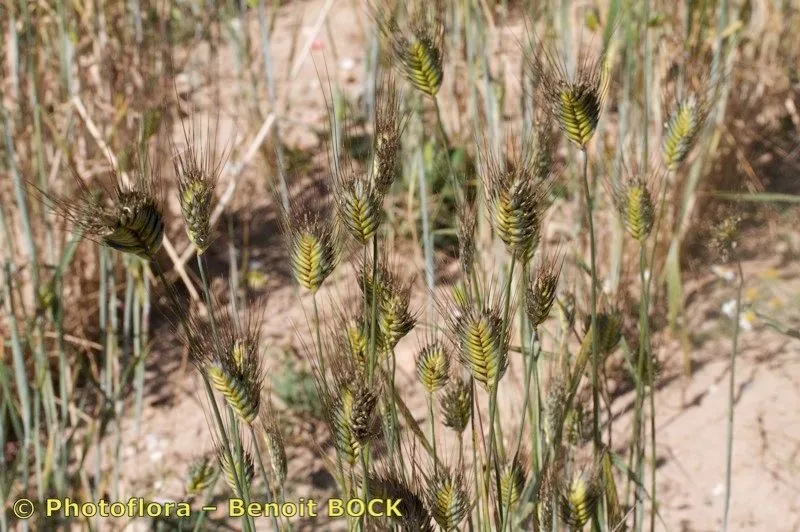
Author: L.
Bibliography: Sp. Pl.: 86 (1753)
Year: 1753
Status: accepted
Rank: species
Genus: Triticum
Vegetable: False
Observations: SE. Europe to Afghanistan
Einkorn, scientifically known as Triticum monococcum, is a notable ancient grain revered for its historical and agricultural significance. It belongs to the Poaceae family, a diverse group of grasses that includes some of the most essential cereal crops. The name “Einkorn” translates to “single grain” in German, reflecting its unique characteristic of having a single grain per spikelet.
This resilient crop has its roots deep in the regions of Southeastern Europe, extending its reach all the way to Afghanistan. This geographical expanse highlights einkorn’s adaptability to various climates and terrains, showcasing its ability to thrive in different environmental conditions.
First described in 1753 by the renowned botanist Carl Linnaeus, as documented in his seminal work “Species Plantarum” (Sp. Pl.: 86), einkorn has held an essential place in early agriculture. Its cultivation dates back to some of the earliest farming communities, making it one of the foundational grains of human civilization.
In terms of genetic makeup, einkorn carries fewer chromosomes than modern wheat varieties, which is significant for those studying plant genetics and breeding. This simpler chromosome structure makes it an important subject in the study of wheat evolution and domestication.
Einkorn’s grain is distinguished by its high nutritional value. It is particularly noted for its high protein levels, antioxidants, and easier digestibility relative to modern wheat, making it an attractive option for people with specific dietary needs or sensitivities.
The profound historical legacy and the compelling nutritional profile of einkorn make it an interesting subject of study and a valuable grain for both historical and modern culinary uses. Its re-discovery in contemporary agriculture points towards an appreciation of ancient grains and their potential contributions to sustainable farming and food diversity.
Deu: einkorn
Fra: engrain, petit épeautre
Dan: enkorn
Eng: einkorn
Swe: enkornsvete
Nld: eenkoren
Spa: escaña menor
En: Einkorn, Einkorn wheat, Small Spelt, One-grained wheat
Ar: قمح وحيد الحبة
Az: Təkdənli buğda
Bg: Еднозърнест лимец
Ca: Espelta petita
Zh: 一粒小麦
Hr: Jednozrna pšenica
Cs: Pšenice jednozrnka
Da: Enkorn
Nl: Eenkoren, Eenkoorn
Eo: Unugrajno
Et: Kultuur-üheteranisu
Fi: Yksijyvävehnä
Fr: Engrain, Petit Épeautre, Blé-riz
De: Einkorn, Eicher
El: Μονόκοκκο σιτάρι
He: איינקורן
Hu: Alakor
Is: Einkornahveiti
Id: Einkorn
It: Farro
Ko: 외알밀
Ml: ഐകോൺ ഗോതമ്പ്
No: Einkorn
Fa: گندم تکدانه
Pl: Pszenica samopsza
Ro: Alac
Ru: Однозернянка
Es: Escaña Menor
Sv: Enkornsvete
Zh-tw: 一粒小麥
Zh-hant: 一粒小麥
Tr: Siyez
Taken Aug 15, 2011 by Photoflora – Benoit BOCK (©)
Taken Jun 24, 2020 by Helen613 (cc-by-sa)
Taken May 21, 2022 by Bernard Sudan (cc-by-sa)
Taken Jul 17, 2019 by Évelyne campagne (cc-by-sa)
Taken Jul 10, 2022 by Karin Guggisberg (cc-by-sa)
Taken Aug 15, 2005 by Photoflora – Jean-Luc TASSET (©)
Taken Aug 15, 2005 by Photoflora – Jean-Luc TASSET (©)
Taken Aug 15, 2009 by Photoflora – Jean-Luc TASSET (©)
Taken Aug 15, 2011 by Photoflora – Benoit BOCK (©)
Taken Apr 25, 2016 by Tela Botanica − Genevieve BOTTI (cc-by-sa)
Taken Apr 22, 2019 by Bernardo Sirca (cc-by-sa)
Taken Jun 21, 2019 by Michele Albert (cc-by-sa)
Taken May 26, 2022 by Michel Pellaux (cc-by-sa)
Taken Aug 31, 2018 by K V (cc-by-sa)
Taken Jun 24, 2020 by Helen613 (cc-by-sa)
Taken Jul 15, 2019 by Photoflora – Jean-Luc TASSET (©)
Taken Aug 15, 2019 by Photoflora – Benoit BOCK (©)
Taken Aug 15, 2009 by Photoflora – Jean-Luc TASSET (©)
Taken Jun 24, 2000 by Tela Botanica − Liliane Roubaudi (cc-by-sa)
Taken Jan 1, 1970 by Photoflora – L’Abbé COSTE (©)
Taken Aug 15, 2011 by Photoflora – Benoit BOCK (©)
Taken Aug 15, 2009 by Photoflora – Jean-Luc TASSET (©)
Taken Aug 15, 2011 by Photoflora – Benoit BOCK (©)
Taken Aug 15, 2011 by Photoflora – Benoit BOCK (©)
© copyright of the Board of Trustees of the Royal Botanic Gardens, Kew.
© copyright of the Board of Trustees of the Royal Botanic Gardens, Kew.
Growth habit: Graminoid
Ph maximum: 7.0
Ph minimum: 6.5
Light: 8
Atmospheric humidity: 3
Bloom months: [‘may’, ‘jun’, ‘jul’]
Soil nutriments: 6
Family: Myrtaceae Author: (F.Muell.) K.D.Hill & L.A.S.Johnson Bibliography: Telopea 6: 402 (1995) Year: 1995 Status:…
Family: Rubiaceae Author: Pierre ex A.Froehner Bibliography: Notizbl. Bot. Gart. Berlin-Dahlem 1: 237 (1897) Year:…
Family: Sapindaceae Author: Koidz. Bibliography: J. Coll. Sci. Imp. Univ. Tokyo 32(1): 38 (1911) Year:…
Family: Asteraceae Author: A.Gray Bibliography: Pacif. Railr. Rep.: 107 (1857) Year: 1857 Status: accepted Rank:…
Family: Fabaceae Author: Medik. Bibliography: Vorles. Churpfälz. Phys.-Ökon. Ges. 2: 398 (1787) Year: 1787 Status:…
Family: Aspleniaceae Author: (Cav.) Alston Bibliography: Bull. Misc. Inform. Kew 1932: 309 (1932) Year: 1932…